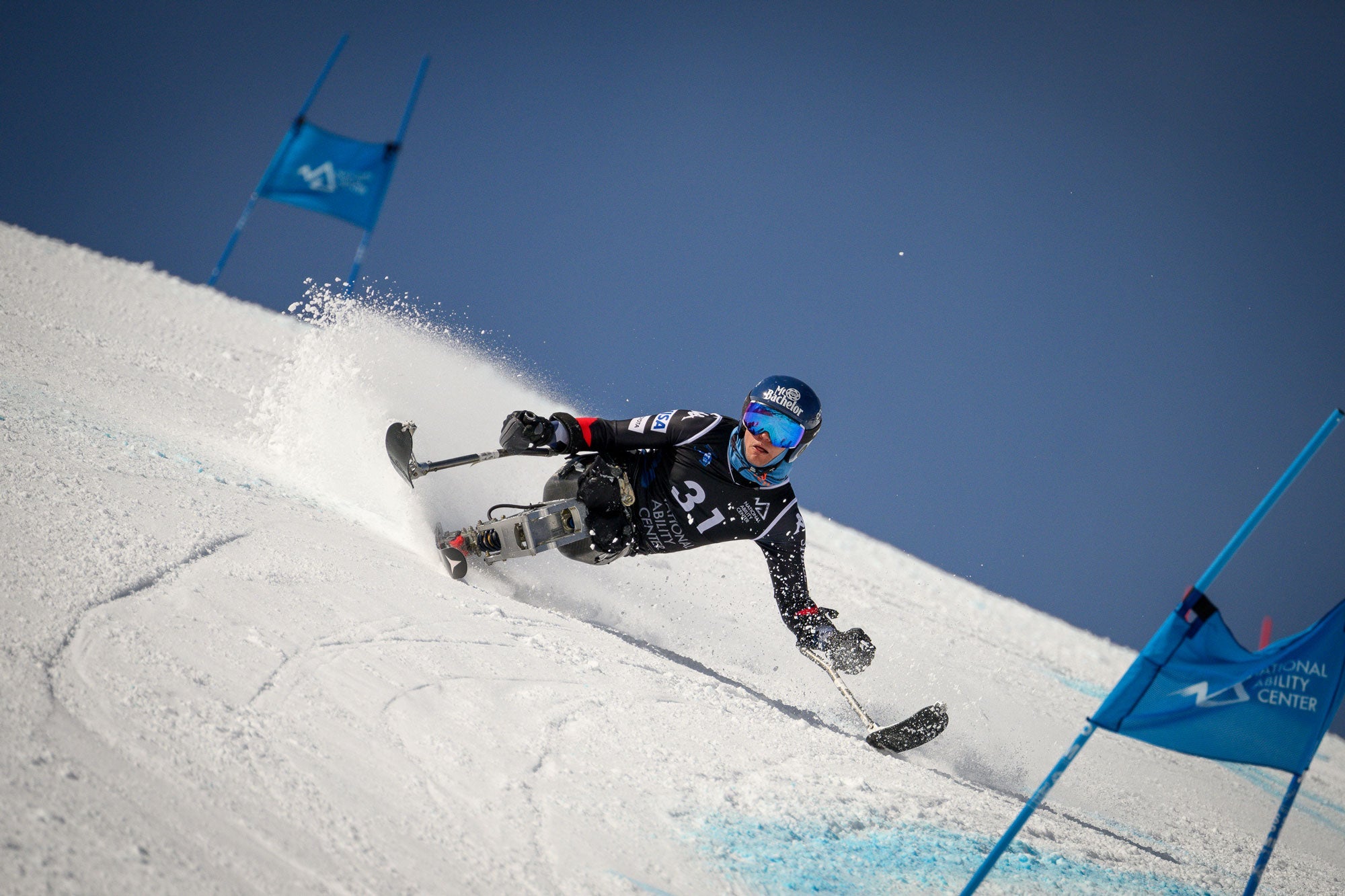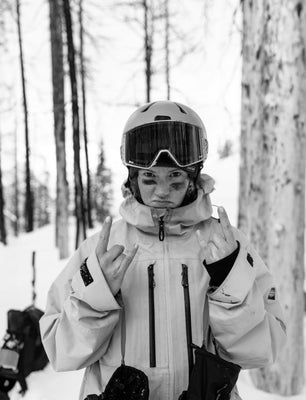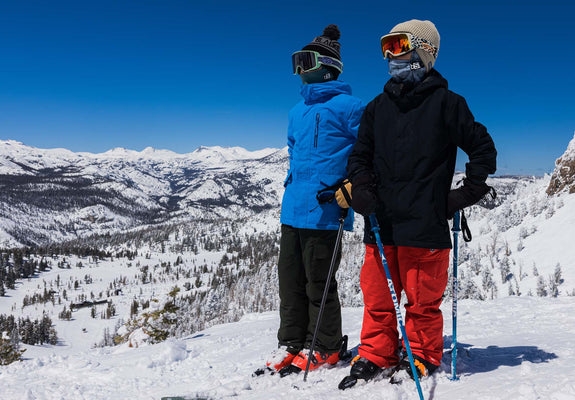Ravi Drugan is not one to slow down. After becoming disabled at age 15 and learning to sit-ski with Oregon Adaptive Sports (OAS) to becoming a Paralympian, Ravi shared insights on his journey, the obstacles he’s faced, and the immense support he’s received from OAS. As he continues to push his limits, Ravi reflects on the importance of community, confidence, and the drive to keep improving both on and off the mountain.

So Ravi, we’d love to hear about your journey in para-alpine skiing, and what it means to you now that you’re doing it on such a high level?
“Yeah man, well, I always say I want to be the best skier I can be. I’m a confident and capable skier, but when you start comparing yourself on a world level, competing in a Para World Cup is the pinnacle. At heart, I’m always a freeskier—I miss just ripping through the trees. But ski racing has made me a more dynamic skier and taught me what skiing truly is on a fundamental level.
Every day, I look back at Oregon and see the snow dumping while I’m racing on man-made ice somewhere else, and yeah, it’s tough. But when you focus on the big picture—being part of the U.S. Ski Team and competing in the Paralympics—it’s such an honor.
It’s always a struggle to leave fresh snow in the Pacific Northwest to race on European ice, but the end goal is what keeps me motivated. This isn’t forever, but it’s an incredible journey that’s making me a better student of the sport and a more well-rounded skier.
I like to say, ‘I ski race to be a better freeskier.’ That’s what keeps me going: the challenge of racing and the love of skiing. For me, skiing—whether it’s freeskiing, racing, or riding the mountain—is about taking on whatever is in front of me. I come from Air Force parents, so to represent the United States as a “Military Brat” is definitely an honor that few and far between get the opportunity to do.”

Tell me a little bit more about what being a Paralympian means to you?
“It’s something I never thought I’d do in my life. When I was a kid, my childhood dream was to be a pro skateboarder in the X Games. I ended up earning a bronze medal in the X Games—but for skiing, not skateboarding. That’s pretty close, though! In a way, it felt like my childhood dream came true.
Ski racing was an opportunity that came my way unexpectedly. It’s not something you can just say you want to do—you have to prove you can do it. Once I got the opportunity and the call to represent my country, it was incredible. To compete on the world stage at the Paralympics and let my family and friends see what I do is a true honor.
It’s definitely one of those things that makes you step back and realize—it’s a pretty amazing thing to do in your life.”

How did your involvement with Oregon Adaptive Sports help pave the way for the Paralympics and your skiing career?
“It’s kind of funny—I skied a few times as a kid at Mount Bachelor, and I remember seeing skiers ripping out of the trees. I’d think, ‘Wow, that’s amazing.’ After I ended up in a wheelchair, the idea of sitting on a chair on one ski sounded impossible—like, ‘You’ve got to be kidding me. That sounds really hard.’
My dad and I used to go to Cougar Hot Springs a lot, and there was a guy there, Chuck, who worked at Hoodoo and with Oregon Adaptive Sports (OAS). He kept telling us we should connect with OAS and give skiing a try. At first, skiing still seemed too challenging, so my dad convinced me to go tubing at Hoodoo one day. As we were tubing, we looked up at the mountain, and my dad said, ‘That’s where we want to be, right?’ And I was like, ‘Yeah, that does look awesome.’
From there, OAS told us to come back anytime, and we did—skied about 180 days that first year. It completely changed everything for me.”
My parents got in touch with OAS, and they set me up with a scholarship for a half-day lesson and provided the equipment I needed. My first instructor was Ben Sparrow, and we skied together that morning. We started with one run down the bunny hill, then straight-lined a few blue runs. By noon, my dad asked Ben, ‘Do you think we could keep skiing and I could take him to the top?’ That’s usually unheard of for someone on their first day, but Ben looked at us and said, ‘Yeah, I think you’ve got it. Go for it.’
So, by noon, I found myself at the top of Hoodoo on a stormy, whiteout day, trying to follow my dad through trees and deep snow. I remember asking him, ‘Is this a black diamond?’ And he just said, ‘Don’t worry about colors or runs. We’re just skiing down the mountain.’ From there, OAS told us to come back anytime, and we did—skied about 180 days that first year. It completely changed everything for me.”
Wow, and when did racing enter the picture after that?
"Well, one day at Mount Bachelor, we were just ripping around when I saw Carl Burnett, a former Paralympian and U.S. Para Ski Team racer who still lives in Bend. I did a run with him, and afterward, he came up to me and said, ‘Have you ever thought about racing?’ I was like, ‘Racing? There’s racing?’ He told me about Paralympic sports and para skiing, and the next year, I went to Winter Park and did my very first race.After that, I raced on and off for a couple of years, but I had a bit of a disagreement with my coach at the time about how much I was freeskiing. He told me I needed to focus on racing, and I told him, ‘If I have to choose, then screw racing—I just want to ski.’ So I stepped away from racing for a while and focused on monoski cross at the Winter X Games. I competed in that for a few years and loved it, but when the X Games cut monoski cross from their events, I started doing smaller freeride events like the Dirksen Derby and the Prequel. Those were fun, but I missed the challenge of racing.

I eventually decided to get back into it and went to Park City, where I trained with an awesome coach, Eric Leirfallom, who’s now the U.S. Ski Team Para Director. For about five years, I spent three months each winter training in Park City. One spring, I got a call from the U.S. team head coach saying, ‘Hey, we’re going to Europe in a month. You’re qualified—do you want to go?’ I was like, ‘Ski more? Sounds great to me!’
I didn’t realize I’d be skiing on bulletproof man-made glacier ice in the Alps. It was a challenge, for sure, but I’ve always said that skiing on ice is where I’m least comfortable. Being out of my comfort zone motivates me to see if I can pull it off, just like I see the other guys doing. Whether it’s an icy World Cup race run or a steep powder line, I want to ski as well—or better—than the last person I saw ski it.
Keep an open mind and go have fun. No matter how many times you fall, when you’re at the top of the mountain looking out, it’s all worth it.
Racing has always been about pushing myself out of my comfort zone. On the World Cup circuit, the competition is fierce. A lot of these guys started ski racing at two or four years old, so coming into it later in life added to the challenge for me. It’s hard work, no doubt, but the motivation is to keep tackling things that scare me—whether it’s standing at the top of the Cortina downhill, staring down a sheet of rock-hard ice, or dropping into a steep tree line.
When you ski down a race run—whether you win or not—and you make it to the bottom, there’s no feeling quite like that sense of accomplishment. It’s the same feeling you get after landing a trick in the terrain park or ripping through a steep fall line. You think, ‘I slayed that. That was sick.’
I’ll keep ski racing as long as I feel like I’m progressing. Once that stops, maybe I’ll move on, but for now, there’s nothing like the rush of pushing myself to new heights. I do want to say, without the support of Oregon Adaptive Sports, I wouldn’t be where I am today. They didn’t just let me go out and play in the snow—they pushed me. They recognized that I had potential and encouraged me to go as far as I could. They’ve always been there to support me.
No matter where I train, where I’m skiing, or who I’m skiing with, OAS will always be my family. They’re the ones who helped me become the skier I am today."

And what would you say to someone who is new to para-alpine skiing or thinking about getting into it?
"Keep an open mind and go have fun. No matter how many times you fall, when you’re at the top of the mountain looking out, it’s all worth it. Honestly, the worst day on the mountain is far better than the best day off it.
It’s not just about the skiing—it’s about the camaraderie. You’ll discover a whole new family out there.
What I’d tell anyone is this: do what you love. If skiing professionally is your dream, that’s amazing, but the real goal is to enjoy nature, the snow, and the mountains in your own backyard. Go out there with your friends—whether they have disabilities or not. For me, some of my best memories are just skiing with my dad.
It’s not just about the skiing—it’s about the camaraderie. You’ll discover a whole new family out there.
Being in a wheelchair, you’re constantly running into obstacles—stairs, inaccessible places—and it can make you think, ‘This isn’t built for me.’ But once I’m on the mountain and in my ski, all of that disappears. Suddenly, everything is doable. Out there, there are no disabilities—just possibilities."
Any closing words or things you’d like to say? What can we expect from the world of Ravi this year?
“Yeah, well, you said it right there, it's pure freedom. You know, there's a lot of great race programs out there and everything, but there's no one better to share the love of the mountain or show you how to do that than Oregon Adaptive Sports in my opinion.
"We just wrapped up a week-long training camp at Winter Park, and now we’re heading to Panorama, Canada, for our first races of the season. After that, we’ll head home for a bit of rest before going to Europe for the first World Cup races.
The goal is always to be on the podium and smoke everyone down the mountain, but as long as you’re happy with your run, making progress, and improving your world ranking, then you’re moving in the right direction. This year, I’m really focused on consistently breaking into the top five. I’ve had a few 5th, 4th, and even 3rd-place finishes, but I want to step onto a course and feel that confidence—like, ‘Yeah, I’ve got this run.’
Looking ahead, I’m working to keep improving and aiming to make it to Cortina next year. When I went to Beijing for my first Paralympics, I didn’t feel completely prepared after just a few years on the World Cup circuit. It was a steep learning curve, and I pushed myself way out of my comfort zone.
This time, my goal is to build my confidence so that when I show up at Cortina, I know I’m ready. The hope is that all this preparation will be good enough to deliver my best performance yet.
But yeah, it’s been a pleasure, so thank you so much for doing this. I really appreciate the support for Oregon Adaptive Sports as well. When people help you get to where you are, the greatest gift you can give back is paying it forward."




